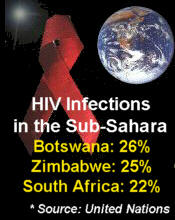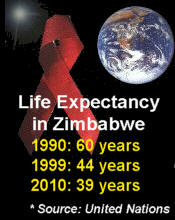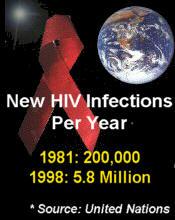 |


|
|
Population/ Economic Growth |
| By Lester R. Brown and Brian Halweil
Courtesy of Worldwatch Institute
 As world population approaches 6 billion on October 12, the HIV epidemic is measurably slowing population growth. Nowhere is this more evident than in sub-Saharan Africa, a region of 800 million people, where the epidemic is spiraling out of control.
As world population approaches 6 billion on October 12, the HIV epidemic is measurably slowing population growth. Nowhere is this more evident than in sub-Saharan Africa, a region of 800 million people, where the epidemic is spiraling out of control.
If a low-cost cure is not found soon, countries with adult HIV infection rates over 20 percent, such as Botswana, South Africa, and Zimbabwe, will lose one fifth or more of their adult population to AIDS within the next decade. When the United Nation's demographers did their biennial update of world population numbers and projections in October of 1998, they reduced the projected global population for 2050 from 9.4 billion to 8.9 billion. Of this 500 million drop, two thirds was because of falling fertility. That's the good news. The bad news is that one third of the fall was the result of rising mortality from AIDS.
All industrial countries have held HIV infection rates of their adult populations under 1 percent but in some countries of sub-Saharan Africa, they have climbed above 20 percent. In Botswana, the adult infection level is 26 percent. In Zimbabwe, 25 percent, and in South Africa, 22 percent. Countries with infection rates of 18 to 20 percent include Namibia, Swaziland, and Zambia. Problems routinely managed in industrial societies are becoming full-scale life threatening crises in many developing ones. As a result, some developing countries with high fertility could nonetheless see their population growth come to a halt in a matter of years because of rising death rates. Although Africa is the epicenter of the HIV epidemic, the virus has also established a strong foothold in southern and western India, particularly in cities such as Mumbai (Bombay) and Chennai (Madras). Other countries with high infection rates include Haiti and Cambodia, with 5 percent and 2.5 percent respectively.
 In sub-Saharan Africa, life expectancy, a sentinel indicator of economic progress, is falling precipitously. In Zimbabwe, until recently a model of economic development in the region, life expectancy has fallen from 60 years in 1990 to 44 years today, and it is projected to fall to 39 years by 2010.
In sub-Saharan Africa, life expectancy, a sentinel indicator of economic progress, is falling precipitously. In Zimbabwe, until recently a model of economic development in the region, life expectancy has fallen from 60 years in 1990 to 44 years today, and it is projected to fall to 39 years by 2010.
Aside from raising mortality, the virus also reduces fertility. With new infections at the highest level in the 15- to 24-year age group in sub-Saharan Africa, many young women will die before they complete their childbearing years. In addition, as the infection progresses toward full-blown AIDS, ovulation often ceases, reducing fertility further. The epidemic affects not just life expectancy and population growth, but virtually every facet of life. In a matter of years, the economic gains of this century could be wiped out, quite literally reversing the march of progress. Health care systems in countries with high infection rates are literally being overwhelmed. In South Africa, 70 percent of the beds in some hospitals are occupied by AIDS victims. Zimbabwe's health minister reports that half the national health care budget has now been diverted to treating AIDS patients. This unanticipated demand on health care systems may deprive many people of even the most basic health care. Food security is also being affected in rural areas of Africa as the loss of adults is leading to labor shortages in the fields. Zimbabwe, where food production has plummeted in 1999, may be one of the first countries to experience this hidden cost of AIDS. In rural areas, the number of able-bodied workers is reduced not only by deaths but also by those who are sick and by those who are obligated to care for the sick. Once one adult family member is bedridden by AIDS, it can compromise the food security of the whole family. Education is also being affected. In South Africa, for example, at the University of Durban-Westville, 25 percent of the student body is HIV positive. In Africa, it is often the better educated, more socially mobile populations who have the highest infection rate. Africa is losing the agronomists, the engineers, and the teachers it needs to sustain its economic development. The epidemic may also indirectly affect capital flows. Companies operating in the countries with high infection rates find the health insurance costs for their employees doubling, tripling, or even quadrupling. Firms that were operating comfortably in the black suddenly find themselves in the red. The combination of rising costs of health care insurance, the loss of workers to AIDS, and the need to recruit and train new workers is making investment in these countries less attractive. As a result, capital inflows may decline and even dry up. What began as an unprecedented social tragedy is translating into an economic disaster.
 The HIV epidemic does not come as a surprise. First identified in 1981, the virus has been infecting more people each year. In 1981, there were 200,000 new infections; in 1998, there were 5.8 million new infections. Preliminary data indicate a far bigger jump in 1999.
The HIV epidemic does not come as a surprise. First identified in 1981, the virus has been infecting more people each year. In 1981, there were 200,000 new infections; in 1998, there were 5.8 million new infections. Preliminary data indicate a far bigger jump in 1999.
Two countries where the epidemic had earlier spiraled out of control have succeeded in checking the spread of the virus: Uganda and Thailand. In each case, the head of state, President Museveni of Uganda and Prime Minister Panyarachun of Thailand, personally assumed a leadership role of the national campaign to control the epidemic. Short of a commitment at this level, it is unlikely that the spread of the virus will be checked in most countries. As world population approaches 6 billion and the virus continues to spread, an inability to confront these trends stems in part from faltering international support for family planning. The same reproductive health care services and the same condoms that help lower birth rates also check the spread of the virus. Unless governments can mobilize quickly to contain the virus, the epidemic could claim more lives in the early part of the new century than World War II did in this one. Lester R. Brown is president and Brian Halweil is staff researcher at Worldwatch Institute, a Washington, D.C.-based research organization. Worldwatch Institute: worldwatch@worldwatch.org Visit Worldwatch's web page on population to learn more about the Institute's population publications and links to other population web sites. |

© 1997-99 BEI